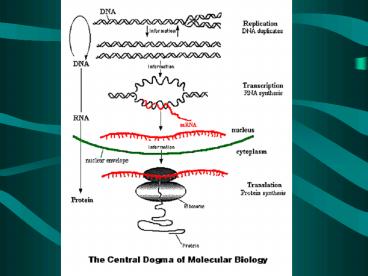CEN 551 - PowerPoint PPT Presentation
1 / 46
Title:
CEN 551
Description:
Central Dogma Movie (A0042201) REPLICATION 5 and 3 Ends of DNA Replication- Making New DNA Enzymes break hydrogen bonds between DNA strands DNA strands separate ... – PowerPoint PPT presentation
Number of Views:91
Avg rating:3.0/5.0
Title: CEN 551
1
(No Transcript)
2
(No Transcript)
3
(No Transcript)
4
(No Transcript)
5
Central Dogma Movie(A0042201)
DNA Movie(A0002902)
6
REPLICATION
7
5 and 3 Ends of DNA
8
Replication- Making New DNA
- Enzymes break hydrogen bonds between DNA strands
- DNA strands separate
- RNA primer added at initiation site to start
DNA synthesis - primer is small piece of RNA that is
complimentary to a specific section of DNA and
will bind to that section of DNA - DNA synthesized by enzyme DNA polymerase
9
- nucleotides of DNA always added to terminal 3
group - Leading strand synthesized continuously
- DNA polymerase must jump ahead and work backward
on lagging strand - DNA fragments on lagging strand are called
Okazaki fragments - Fragments joined by an enzyme called DNA ligase
10
DNA Replication
11
Replication is Semi-conservative
12
EM photo of E. coli DNA Replication
13
(No Transcript)
14
DNA Replication Movie(A0002701)
15
TRANSCRIPTION
16
Transcription RNA Synthesis
- Necessary parts of DNA become unbound
- One strand is the template for each gene.
- Definition of a gene encodes for one protein
- RNA polymerase reads DNA and synthesizes mRNA
- RNA polymerase consists two parts core and sigma
subunit
17
Transcription (continued)
- Three steps Initiation, elongation, termination
- An operon (in procaryotes) consists of a
promoter, genes, and a terminator - Initiation begins with binding of sigma factor to
promoter region of DNA
18
(No Transcript)
19
Transcription (continued)
- Promoters vary in binding affinity for the sigma
factor - When the sigma factor is released, elongation
begins - MRNA synthesis stops when RNA polymerase
encounters a terminator (specific sequence of
bases) (can vary in strength also)
20
(No Transcript)
21
(No Transcript)
22
(No Transcript)
23
(No Transcript)
24
Transcription (continued)
- Procaryotic transcription can be polygenic
(multiple genes controlled by one promoter) - In procaryotes, transcription and translation
occur simultaneously. - mRNA in eucaryotes can have nonsense segments,
called introns - Introns make it more difficult to transfer
eucaryotic genes to procaryotes
25
RNA Post Processing (Eucaryotes)
exon intron exon
intron degraded before translation
mRNA rejoined
26
Eucaryotic mRNA Processing Movie(A0158701)
27
(No Transcript)
28
Transcription Movie(A0001001)
29
TRANSLATION
30
Translation Making Protein
- Three steps again Initiation, elongation,
termination - In procaryotes, initiation is the formation of a
30s and 50s rRNA initiation complex. - rRNA means ribosomal RNA, 30s and 50s are the
sizes of two parts of the ribosome - Elongation uses tRNA with attached amino acids
- Three letter words of four possible letters
(U,C,A,G) form codons on mRNA (64 possible,
many redundant) - anti-codons on tRNA match the codons on mRNA
31
(No Transcript)
32
tRNA Structure
33
Code for Protein Synthesis
34
Translation (continued)
- Three codons (UAA, UAG, and UGA) do not code for
amino acids and are stop codons. Translation
stop, or translation terminations sequence. - Translation start codon is AUG.
- Two sites on the ribosome for the tRNA called P
and A
35
(No Transcript)
36
(No Transcript)
37
(No Transcript)
38
(No Transcript)
39
(No Transcript)
40
(No Transcript)
41
(No Transcript)
42
Translation Movie (A0001404)
43
Posttranslational Processing
- Folding chaperones (proteins) that assist in
folding. - Secretion signal sequence a sequence of 20-25
amino acids on the front of a protein that
directs the protein to be secreted out of the
cell. The signal sequence is clipped off during
secretion. - Glycosylation addition of sugars to the protein
structure.
44
Secretion
- Procaryotes secretion through the cytoplasmic
membrane. - Eurcaryotes transport vesicles bud around the
proteins and transport to the membranes.
45
Three main mechanisms by which membrane-bounded
organelles import proteins. The protein remains
folded during the transport steps in mechanisms 1
and 3 but usually has to be unfolded in mechanism
2. All of these processes require energy.
http//www.accessexcellence.org/AB/GG/Anchor-Cell
-33869
46
Glycosylation
- N-linked glycosylation is only accomplished in
eucaryotic organisms. - Glycosylation pattern is a target for the body to
clear (remove) proteins. Non-native
glycosylation patterns will be removed. Critical
implications for producing therapeutic proteins
for human injection.

